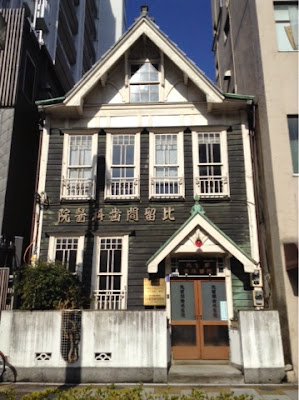
After a too long break I went to my Japanese class (which is basically drinking tea while reading articles about Japanese history, culture, craft and arts) and Takeda-san (my teacher for more than 10 years now) told me about a nice exhibition in a small museum in Roppongi: the Sen Oku museum. The exhibition features the collection of Nagano’s “classic museum” meisen (銘仙) kimonos. Meisen kimonos are some kind of cheaper kimonos made of lower quality silk, and that became super popular in Taisho period and early Showa. And as you may remember, this is one of my favorite period in Japanese history (see my earlier post on Taisho period and Taisho architecture). The meisen kimonos are very colourful, with many large patterns made with stencils with a very interesting technique of dying. I recommend you read this very nice article about meisen techniques from Anna Jackson of the Victoria and Albert Museum if you want to know more about it. Her article features many pictures of the making.

Coincidently, my favorite kimono magazine: Kimono hime (kimono姫), had its new issue on meisen. With as usual, tons of beautiful pictures that make you want to wear kimonos every day, and some nice places to visit in the region of Chichibu, a place known for making meisen kimonos. I thought this was a sign and time to go and explore meisen. After a quick check going to Chichibu is not far from Tokyo but a rather crowded drive on week-ends in particular in autumn because of the surrounding nature. So we postponed the trip there for a day we can go during the week. Instead we headed to the museum in Roppongi and went to see the exhibition. It’s a small exhibition, so it didn’t take much time, but the kimonos exhibited were really nice and the movie explaining the making was also really interesting. It revived my love for wearing kimonos, for mo-ga fashion, and for modern Japanese paintings. It revived it so much that when out of the exhibition I had colorful patterns in my eyes and in my mind and it came naturally to us to go to Ginza to visit a few art galleries that have modern Japanese painters.

The tour was quite quick, we park in front of Tamenaga, that will have a Foujita exhibition starting Sunday, so we decided to come back on Sunday. Then we headed to an other one where didn’t find what we were looking for, finally browsing some leaflet, we found that Shihoudou may have what we are looking for and went there while stopping on our wayhere and there in others. And yes! Shihoudou had exactly what I had in mind, a simple modern psinting of a girl in a colorful kimono. I love so much the contrast of the kimono and the european style painting, it is just the essence of this period for me. I dream of having such a painting!



